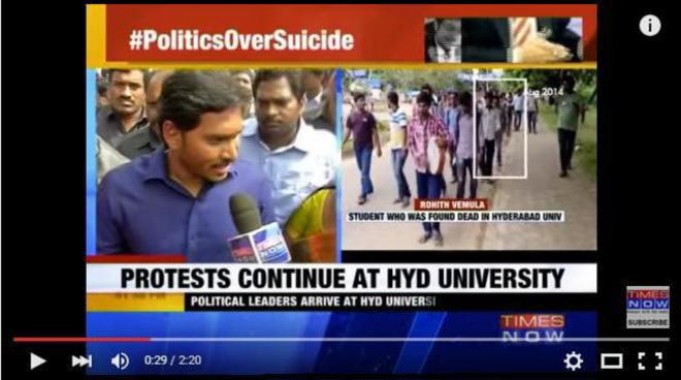Requiem for a demonised university
‘Occupy shopcom’ is perhaps an apt description of the campus of University of Hyderabad. Subdued criticism of lack of political spaces in campuses, more so in recent times, can be countered with the continuous stream of political dignitaries and their commiseration for the agitation. The agitation is now in the public sphere and the institution has been labelled… OB vans and microphone wielding journalists looking for sound and video bytes to feed into the media have become a part of the otherwise quaint and large campus. Detractors would argue that the calmness does not reflect the discontent and the systemic negation of the academic and societal aspirations of the weak and marginalised. The demonization is complete and the fact that the university’s overall institutional profile is comparatively on a good standing cannot be cited under the tragic cloud that presently besieges it. It will take a long time for the wounds to heal but the scars will remain forever.
The situation is in full public glare now. Discourses in the media by hard-hitting anchors and panellists who need to jostle to join the debate, have told the “faculty” to reform and what should be done to get out of our mindsets and face the social reality around us. Amidst this din, there is not even a parting reference to how and whether academic and teaching normalcy should be restored at all. When the “university” is in the dock and in full mob dynamics, such talk smacks of insensitivity and how the priorities should be recognised.
Fair enough, but have the intellectuals and others considered the full import of the situation. The administrative block and all other academic units are under lock and key with no clue as to where and with whom the keys are. The roads to all academic spaces are blocked with felled trees and stones and any attempt to get into the offices requires negotiation with the students. Issues apart we need to debate and understand what institutional responses can be there. While students are cheering leaders and their exhortations, a few faculty members who visited the shopcom (the university shopping complex which is the hub of the protest) were booed and sent back with slogans. We realised the mood was not conducive. If the faculty and its negotiation fails with its own students it is indeed a sad reflection of the inability of the system to move ahead.
The semantics of the wording of the decisions apart, demands within the realm of the University have been met, notwithstanding the rejection by the Joint Action Committee (JAC) spearheading the agitation and protests. Demands in the realm of the law and order machinery are beyond the scope of the University.
With the matter already in the Court and also to be enquired into by a one-man judicial commission, the facts will come out despite the fact that castigation and indictment of the university fraternity, particularly the teaching community are already recurrent frames of media focus. That the University has had a string of such tragedies in the past is undeniable, and debating whether adequate systemic responses were put in place or not is not much help in our moment of crisis.
Although detailed quantitative analysis of the media coverage was not attempted, it was evident that the media indicted the institution. Very little scope was afforded for any voice that attempted to understand the tragedy and the implications of the complete blockade of all administrative and academic spaces. The administration came to a complete standstill with hundreds of employees coming each day and students having no clue as to when and if classes will be held at all. The call for justice and the surrounding events and speeches provided enough grist for the media's mill.
Umpteen occasions and coverage of such crises have always thrown up the responsibility aspect of our media. Its more than watchful watchdog function is performed with utmost shrillness. Did it look beyond shopcom (when it had the means and OB facility) and capture the blocked roads and locked school buildings? perhaps not. Did it capture the views of the students who wanted classes and were not willing to be on camera? Perhaps not. What about the research laboratories that needed maintenance and safety checks, and what about many faculty who notwithstanding their commiseration for the agitating students, were concerned about their research scholars’ work and classes? The community silently lamented the lack of such concerns even among the eminent academics and education administrators who formed the axis of coverage. The media seemed oblivious in its quest for prime time justice.
In time, the event will pass and the wounds will take a long time to heal. The scars will remain. Many questions that the media may not want to ask pertain to our campuses. What should the internal community team of faculty and administrators do when the campus is under virtual siege and closure? With never ending debates on whether, when and if the law and order machinery should be called in, whose responsibility it is then to restore normalcy. Like minded teams are asked to negotiate in open spaces with the PA system and media glare on and a prevalent mob psychosis and dynamics. Although patience is the key word, the attempts are only futile and unrelenting.
A University that has good comparative credentials went through both a public and media trial and the verdict is murmured. While it is only fair that justice is provided, it is equally fair for us to reflect how the Institution was treated from within and in its representations outside. Relatively, death is both tragic and traumatic but in the process the larger concern about what kind of requiem did the University’s image have, remains.







